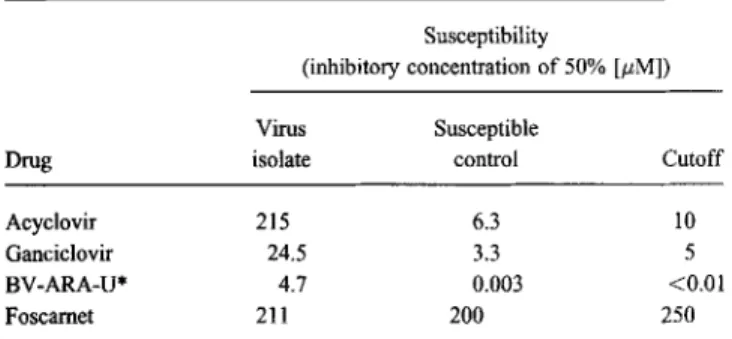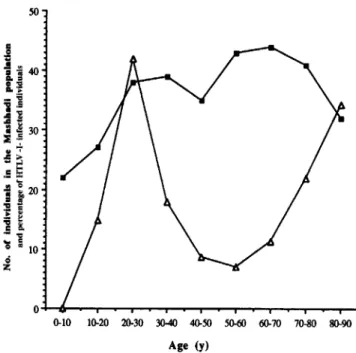864 Brief Reports em 1996;22 (May) In conclusion, S.boydiishould be considered among the rare
but possible causes of vertebral osteomyelitis.
Robin Patel, Douglas R. Osmon, James M. Steckelberg, Mark B. Dekutoski, and WalterR.Wilson Division ofInfectious Disease and Internal Medicine, and Department of Orthopedics, Mayo Clinic, Rochester, Minnesota
Outer Retinal Necrosis Due to a Strain of Varicella-Zoster Virus Resistant to Acyclovir, Ganciclovir, and Sorivudine
The inhibitory activityof acycloviris basedon its phosphorylation by the viralthymidine kinase(TK). Afterpatientswith AIDSreceive long-termtreatmentwith acyclovirfor the controlof infections with herpes zoster and herpes simplex viruses, resistant isolates may appear. Most of the resistant strains are either deficient in TK or inducea TK with an alteredsubstratespecificity [I, 2]. Foscarnethas a differentinhibitionmechanismand is the established alternative in these cases [3]. However, its toxicity and the need for intravenous administration are drawbacks. Sorivudine is one of the most active compounds against varicella-zoster virus (VZV) [4] and has favor-able pharmacokinetics permitting once-daily administration. How-ever, as its inhibitory mechanism is also based on the phosphoryla-tion by the viral enzyme,strainswith an alteredTK [I, 5] may have reduced susceptibility to sorivudine as well.
Disseminated necrotic skin lesions developed in May 1994ina 38-year-old woman with AIDS. These lesions diminished but never disappeared completely, despite the administration of high doses of oral acyclovir (5 X 800 mg/d),On21 October outer retinal necrosis occurred in herrighteye.Treatment withfoscarnet (10g/d)was started on 23 October. The skin lesions healedbut she lostvision in her right eye, and the retinawas completely detached by 26 October.
On 7 November treatment with foscamet was interrupted be-cause of renal failure, and treatment with sorivudine was started at reduced dosages of 40 mg every 2 days (usual dose, 40 rng/d). Skin lesions did not recur during therapy with sorivudine. How-ever, retinal lesions appeared in her left eye on 8 December.Treat-ment with foscamet was started again, combined with intravitreal administration of ganciclovir (200f-Lgtwice weekly). The retinal lesions responded, but her vision decreased on 24 January 1995 and progressed to blindness on 27 January. Treatment with sori-vudine was discontinued on II January because of thrombocyto-penia (nadir 10,000 platelets/ul.), and foscamet was withdrawn on 8 February. The patient died on 15 March.
Before treatment with foscarnet was started, VZV was isolated from CSF obtained by a lumbar puncture (21 October 1994); the virus was grown on fibroblasts. No other viruses were detected at
Reprints or correspondence: Dr. Werner Wunderli, Laboratoire Central de Virologie, Division des Maladies Infectieuses, Hopital Cantonal Universitaire, 1211 Geneve 14, Switzerland.
Clinical Infectious Diseases 19%;22:864-5 ©1996 by The University of Chicago. All rights reserved. 1058-4838/96/2205-0041$02.00
References
1.Twum-Danso K, Marwah S, Ahlberg A. Shigella osteomyelitis in a fit young man. Trop Geogr Med 1993;45:88-9.
2. Rubin HM, Eardley W, Nichols BL.Shigella sonnei osteomyelitis and sickle
cell anemia. AmJ Dis Child 1968; 114:83-7.
3. Rothman PE. Dysentery bacillemia. J Pediatr 1936;9:167-72.
Table 1. Susceptibility of the VZVisolate to various antiviral drugs. Susceptibility
(inhibitory concentration of 50% [J.lM])
Virus Susceptible
Drug isolate control Cutoff
Acyclovir 215 6.3 10
Ganciclovir 24.5 3.3 5
BV-ARA-U* 4.7 0.003 <0.01
Foscarnet 211 200 250
NOTE. Human foreskin fibroblasts were seeded in 12-well plates. VZV-infected cells were seeded at a concentration that yielded 50-100 plaques per well and were incubatedinthe presence of antiviral drugs. After 4 days of incubation, plates were fixed and stained with Wright-Giemsa.
* [1-.B-o-arabinofuranosyl-E-5[2-bromovinyl] uracil.
that time in bronchoalveolarlavage fluid, blood, saliva, throat swab specimens, or urine.
In addition,nested PCR revealed VZV DNA in anterior chamber fluid. PCR for cytomegalovirus, herpes simplex virus, and
Tox-oplasma gondiiwas negative. In each reaction with material from the patient, two H20samples were included as a negative control; a positive control was includedas well. Primers from the following genomic regions were used: the membrane glycoprotein gpIl re-gion for VZV; the IE rere-gion for cytomegalovirus, the gene rere-gion of UL42 for herpes simplex virus, and the B, gene repeat for
T. gondii. In addition, 10 f-LL of the extracted DNA was used to amplify theTNF-agene in a single-roundpeR. The product of the inner PCR was checked for size on an agarose gel.
The VZV isolate replicated rapidlyincell culture, and the plaque reduction assay revealed resistance against acyclovir, ganciclovir, and BV-ARA-U (defined in table 1), although the patient had never been treated withBV-ARA-U before. The viruswassusceptible to foscarnet.
Long-term administration of acyclovir to this patient with AIDS selected multiresistant VZV, which was also resistant to the potent VZV inhibitor sorivudine. This multiresistance was probably due to an altered or lacking TK and left only foscamet as a treatment option, although this approach was seriously hampered by renaltoxicity. This observation demonstrates the need for alternative nontoxic antiviral drugs with different mechanismsthanthe inhibition of TK.
Werner Wunderli, Richard Miner, Joelle Wintsch, Sylviane von Gunten, Hans H. Hirsch, and Bernard Hirschel Division des Maladies Infectieuses, Hopital Cantonal Universitaire, Geneve, Switzerland; Mount Zion Medical Center, San Francisco, California, USA; and Institute of Medical Microbiology, Basel, Switzerland
em
1996;22 (May) Brief Reports 865 References1. Boivin G, Edelman CK, Pedneault L, Talarico CL, Biron KK, Balfour HHJr.Phenotypic and genotypic characterization of acyclovir-resistant varicella-zoster viruses isolated from persons with AIDS. J Infect Dis 1994; 170:68-75.
2. Erlich KS, Mills J, Chatis P, et al. Acyclovir-resistant herpes simplex virus infections in patients with the acquired immunodeficiency syndrome. N EnglJMed 1989;320:293-6.
Age Distribution Among Patients at High Risk for Human T-Cell Lymphotrophic Virus Type I Infection
Human T-celllymphotropic virus type I (HTL V-I) is a human retrovirus associated with adult T cell leukemia and tropical spastic paraparesis. We recently reported a high incidence of HTLV-I infection in Israeli Jews originating from the city of Mashhad in Iran [1, 2]. There is a characteristic age-dependent increase in the seroprevalence of HTLV-I infection in areas of endemicity. This increase typically occurs in adulthood and is higher in females than in males throughout their lifetimes [3, 4]. Itis not fully understood whether age, immunity, and the CNS are distinctive factors or cofactors associated with morbid-ity in elderly populations. We designed the present study to investigate whether there is an age-dependent increase in the incidence of HTLV-I infection in a population at high risk; the results of our investigation were designed to be used as a model for CNS infectivity in the elderly.
The Jews of Mashhad were persecuted because of their religious beliefs since 1747, but they secretly continued to practice the Jewish religion and to intermarry, resulting in families that are closely related genetically. We included321 Iranian Jews of Mash-hadi origin (either the subject or at least one of his or her parents was born in Mashhad) in our study. All subjects underwent physi-cal and neurologiphysi-cal examination, and samples of peripheral blood were obtained from each subject after informed consent was ob-tained. Sera were tested for antibodies to HTLV-I with use of the gelatin-particle agglutination test, and genomic DNA was ampli-fied as previously reported [2]. Statistical analysis was performed with analysis of variance (ANOVA).
Of the 321 subjects included in the study, 203 were female and 118 were male (mean age z SD, 45.7::':: 22.3 years). Fifty-eight(18%) of the 321 subjects (38 females and 20 males; mean age z SD, 50::':: 17.3 years) were positive for HTLV-I antibody by serological testing and bypeR analysis. Of the 58 HTLV-I infected subjects, 36 were asymptomatic carriers, whereas 22 (14 females and 8 men; 38%) had signs of spastic paraparesis. None of the 263 subjects who were not infected had abnormali-ties of the pyramidal tract compatible with spastic paraparesis.
Reprints or correspondence: Dr. A.Achiron, Multiple Sclerosis Center, Sheba Medical Center, Tel-Hashomer, 52621 Israel.
Clinical Infectious Diseases 1996;22:865-6
©1996 by The University of Chicago. All rights reserved.
1058-4838/96/2205 -0042$02.00
3. Coen OM. The implications of resistance to antiviral agents for herpesvirus drug targets and drug therapy. Antiviral Res 1991; 15:287 - 300. 4. Shigeta S, Yokota T, Iwabuchi T, et al. Comparative efficacy of antiherpes
drugs against various strains of varicella-zoster virus. J Infect Dis 1983; 147:476-584.
5. Talarico CL, Phelps WC, Biron KK. Analysis ofthe thymidine-kinase genes from acyclovir-resistant mutants of varicella-zoster virus isolated from patients with AIDS.JVirol 1993;67:1024-33.
50
o-l--6--..,.---..,.---..,.---..,.---..,.---..,.---..,.--...~.... 0-10 10-20 20-30 30-40 40-50 50-60 60-70 70-80 80-90
Age (y)
Figure 1. Age-related distribution of HTLV-I infectivity in the Mashhadi Jewish population. The number of individualsin the Mash-hadi Jewish populationis representedby •. The percentageof HTLV-I infected individuals by age group is represented by1:,..
The age distribution among the various decades ofthe Mashhadi population being studied is presented in figure 1. The age distribu-tion of HTLV-I-infected subjects was significantly different from that of the healthy Mashhadi population (P
<
.01); in addition, the incidence of infection was distributed in a bimodal pattern, with a peak in the incidence of infection in young adulthood (20-30 years old) and a gradual rise reaching a second peak in the incidence of infection in the very elderly(80-90 years old).The HTLV-I infection rate(18%) in the Mashhadi population in the present study is similar to that found in our previous studies [1,2]. The most striking finding in the present study was the high rate of infection among the elderly population (>60 years old). This finding is an extension of the reported clustering of I infection within a nursing home for Mashhadi elderly [1]. HTLV-I is known to be transmitted by sexual intercourse [5], from mother to child in breast milk [6], via blood transfusion [7], and by sharing of needles by parenteral drug abusers [8]. These modes of transmis-sion can account for the early peak of HTLV-I infection in the younger population. However, the increase in the incidence of HTLV-I infection in the elderly is poorly understood since

